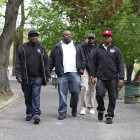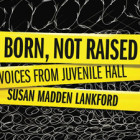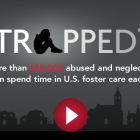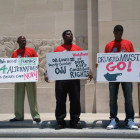
The Art of Interrupting Deadly Youth Violence
|
“I want these gang members to know it ain’t the only way,” said Rico, a 27-year-old standing in the doorway of a dusty bodega on Kingston Avenue in Brooklyn.
Juvenile Justice Information Exchange (https://jjie.org/author/clayduda/)

“I want these gang members to know it ain’t the only way,” said Rico, a 27-year-old standing in the doorway of a dusty bodega on Kingston Avenue in Brooklyn.

The most engaging elements came from the kids themselves. Scrawled on the bottom of handouts, the backs of postcards or between the lines of wrinkled notebook paper, the writings from the kids in a San Diego-area juvenile hall provide a window into much more than just their mind and soul. “I Really don’t Remember my childhood because I’ve tried so hard to block it out,” Brown, a 16-year-old girl inmate, wrote as part of an assignment “Born, Not Raised” author Susan Madden Lankford handed out. “The earliest memory I have is at the age of 11 when I was malested by my grandfather.”
Some wrote elegantly, poetically even, with a form that can only come from practice and attention in literature class – or perhaps just attending class at all. Others struggled to string together coherent sentences, or express their ideas and feelings in terms that could be understood.

It might make for a more leisurely summer, but Kennesaw State University student Steven Welch didn’t dump college courses to have more free time. He did it because he couldn’t afford the cost. Welch, 24, had to make the move because he no longer qualified for a Pell Grant to cover the cost of summer tuition. Restrictions on the grant program, long used to help low-income and some middle-class students stem the cost of higher education, were enacted by Congress last year -- but students are feeling the impact for the first time this summer as the changes are implemented across the country. Before this summer, students could use more than the allotted $5,550 per year to help cover the cost of tuition and other school related expenses.

Each year, more than half a million children come into contact with the foster care system in the United States. Of those, 80 percent suffer from severe emotional problems, according to a report by the American Academy of Pediatrics. Less than 50 percent receive their high school diploma, and far fewer go into any type of post-secondary education. Those are some of the statistics, but what’s it’s like to walk in their shoes? What’s it like to face the tough challenges and choices these young men and women deal with on a daily basis?

Nearly a decade after Louisiana committed to sweeping changes to the state’s struggling juvenile justice system, some advocates contend the governor and leaders in the state’s Office of Juvenile Justice are “backsliding” on their commitments to reform. Advocates gathered on the steps of the state Capitol last week to unveil a report, “What’s Really Up Doc?: A Call for Reform of the Office of Juvenile Justice.” The 43-page document calls for the state’s recommitment to adopting a more therapeutic approach to juvenile justice based on the Missouri model as well as commitments to increase funding for community-based programs and replace some of OJJ’s top brass, among other goals. “In 2003, the state of Louisiana recognized that juvenile justice reform produced better outcomes for its citizens, youth and families, and made a commitment to this path,” the report said. “A decade later, the state has unfortunately strayed from this commitment, with facility and OJJ practices that are contradictory to the goals of reform.”
The state adopted reform legislation in 2003, also known as Act 1225, on the heels of highly publicized violence within youth detention facilities and litigation with the Department of Justice that found conditions of confinement for some youth in the system unconstitutional. Modeled after Missouri’s system that places an emphasis on rehabilitation and community-based programs rather than detention for troubled youth, Louisiana’s program was dubbed LAMOD – or the Louisiana Model.

Juvenile crime rates in the state of New York, but excluding New York City, fell 17 percent between 2010 and 2011, according to new data from the state’s Division of Criminal Justice Services (DCJS). Not including New York City, there were more than 2,000 fewer juvenile crimes committed in New York state in 2011 compared with the previous year, according to the annual report. The state saw 12,325 juvenile arrests in 2011, versus 14,864 in 2010. Within New York City, formal juvenile arrests dropped three percent and felony arrests fell 11 percent compared with the previous year, according to crime rates from the New York [City] Police Department presented in the DCJS annual report. Robbery was by far the most common type of serious offense, making up 77 percent of the state’s and 74 percent of New York City’s Juvenile Offender (JO) arrests – a special designation by the state covering the most serious juvenile offenders and crimes.

Drop out factories. Since coined by a Johns Hopkins researcher working on high school dropout issues in 2004, that’s the name given to schools that lead our nation in dropout rates, graduating less than 60 percent of their students each year. Around the country, half of the more than 1 million students that fail to graduate high school each year come from just 12 percent of the nation’s schools, according to U.S. Department of Education statistics. President Barack Obama, retired General Colin Powell and Secretary of Education Arne Duncan, among others, have taken notice. Since 1980, dropout rates around the United States have decreased – and graduation rates are up – but nearly one in four public school students still leave high school without a diploma.

The Justice Department released a landmark ruling on Thursday to help protect juvenile offenders from falling victim to sexual abuse in adult prisons. The ruling marks the first-ever federal effort aimed at setting standards to protect inmates, both juvenile and adult, in correctional facilities on the local, state and federal level. “The standards we establish today reflect the fact that sexual assault crimes committed within our correctional facilities can have devastating consequences – for individual victims and for communities far beyond our jails and prisons,” Attorney General Eric Holder said in a DOJ release. The standard also restricts the placement of juveniles in adult facilities, aiming to protect youth from sexual abuse by limiting contact between youth and adults behind bars through four specific requirements:
Prohibiting the placement of youth in the general adult prison population
Eliminating contact between adults and youth in common areas,
Ensuring youth are under constant supervision
And limiting the use of isolation for juveniles. States that will be most affected by the new regulations are the 13 states that end juvenile court jurisdiction before the age of 18.

If passed, a California law will make it the first state in the nation to ban controversial therapy aimed at turning gay and lesbian teens straight. State Sen. Ted Lieu (D-Torrance), sponsor of the bill, said the so-called reparative therapy wrongly treats homosexuality as a disease and can be harmful to minors. “Some therapists are taking advantage of vulnerable people by pushing dangerous sexual orientation-change efforts,” Lieu told the state’s Senate Judiciary Committee last week. “These non-scientific efforts have led in some cases to patients later committing suicide, as well as severe mental and physical anguish.”
As it’s written, SB 1172 would ban juveniles under the age of 18 from undergoing “sexual orientation change efforts” (SOCE) and require adults considering treatment to sign consent forms stating they understand the therapy has no medical basis and the potential dangers. The bill has already passed two Senate policy committees and is due for a vote on the Senate floor, liking within the next month.

After nearly 35 years of operation, Public/Private Ventures (PPV) will close by the end of July. The decision came after the Board of Directors concluded that, given current funding trends and economic conditions, PPV operations were not sustainable despite staff cuts and support from numerous private funders. “We’ve been monitoring our finances for well over a year with the prospect that we might have to plan for a wind-down if we didn’t secure the kind of dedicated funding PPV has enjoyed in the past,” said PPV President Nadya Shmavonian. “But [that foresight] will allow us to do this in as responsible a manner as possible, with a real priority on moving the work and projects to a new homes.”
PPV, a national non-profit with offices in New York City, Philadelphia and Oakland, has worked to improve the effectiveness of social programs around the country, with a particular focus on young people from high-poverty communities. The organization has about 40 active projects, and has already began the work of “winding down” -- finding suitable organizations to continue the programs, on a project-by-project basis.